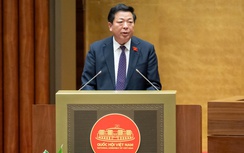Speaking at the 10th session of the National Assembly on November 7, Minister of Construction Tran Hong Minh said the draft Law on Urban and Rural Planning clearly defines the hierarchical system of planning, including general, subdivision, and detailed levels.

Minister of Construction Tran Hong Minh speaks during the National Assembly’s discussion session on November 7.
At the provincial level, the draft simplifies the system to two types of plans — general and detailed. In stable areas, only detailed planning will be required.
Regarding administrative decentralization, the Minister emphasized the need to define clearly the authority of central, provincial, and communal governments to avoid assigning tasks beyond local capacity.
"In many localities, planning work faces challenges due to a shortage of qualified technical staff. Not every commune can independently handle land surveying or project design — they must hire professional consultants. The commune’s role is to coordinate, advise, and oversee implementation," he explained.
Even at ministerial or provincial levels, consulting services remain essential, the Minister added. All planning proposals must be reviewed and approved by the relevant Standing Committees, People’s Councils, and competent authorities before ratification.
On urban classification, Minister Tran Hong Minh noted that Vietnam currently has two special-class cities — Hanoi and Ho Chi Minh City — and six centrally governed cities. The Ministry of Home Affairs and the Ministry of Construction are working together to revise the criteria for classifying special-class, first-class, and centrally managed cities.
For first-class cities, the upcoming amendments will define them as national-level urban centers based on 15 standards across three key groups: scale, national and international influence, and core infrastructure.
He stressed that revising the Law on Planning and the Law on Urban and Rural Planning aims to refine the legal framework in line with Vietnam’s two-tier local governance model.
"Planning is the backbone of socio-economic development. Without coherent planning — or with poorly implemented plans — development risks becoming fragmented, harming landscapes, the environment, and sustainable growth," he said.
The Minister also proposed extending the planning horizon beyond the current 10–30 years. "We should adopt a longer-term vision of 50 to 100 years, as many developed countries have done," he suggested.
He noted that given Vietnam’s resources, planning will continue to be implemented in stages, currently for the 2021–2030 period, with a long-term vision to 2050.





Bình luận bài viết (0)
Gửi bình luận